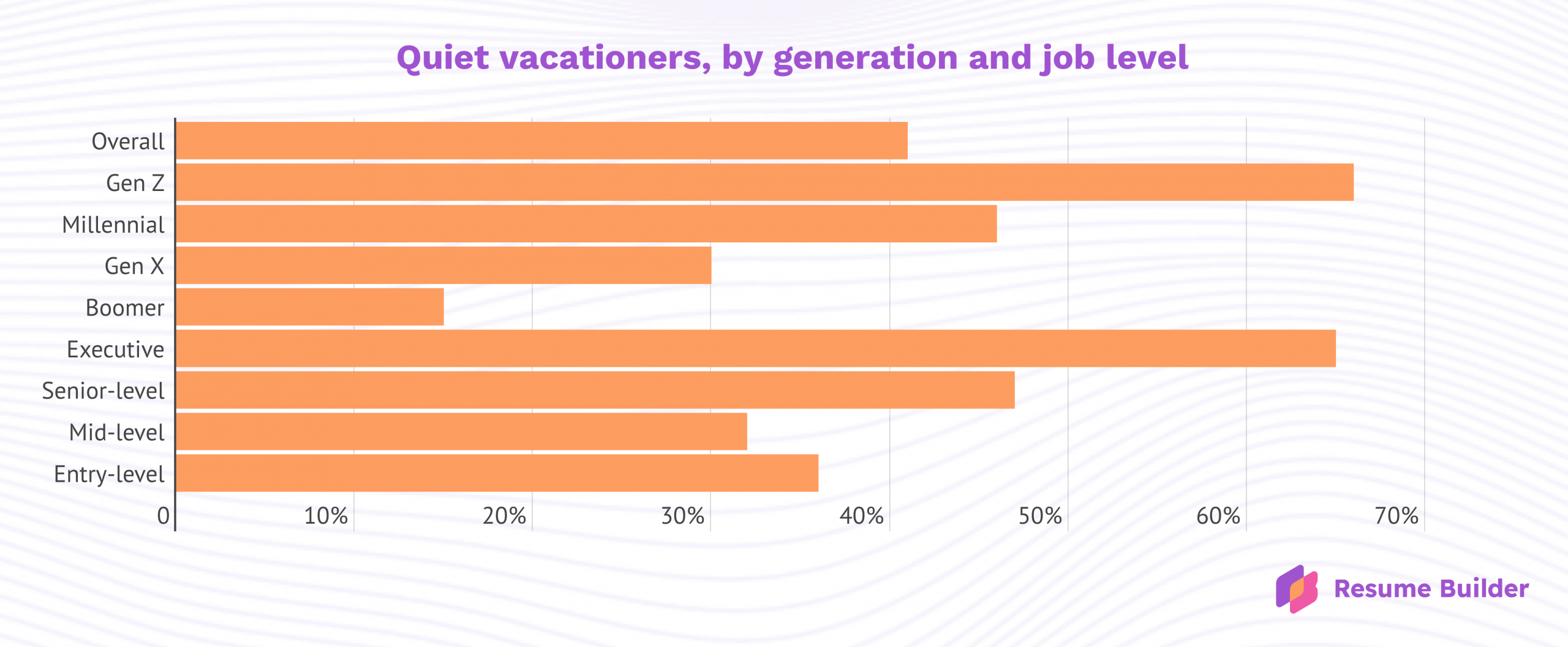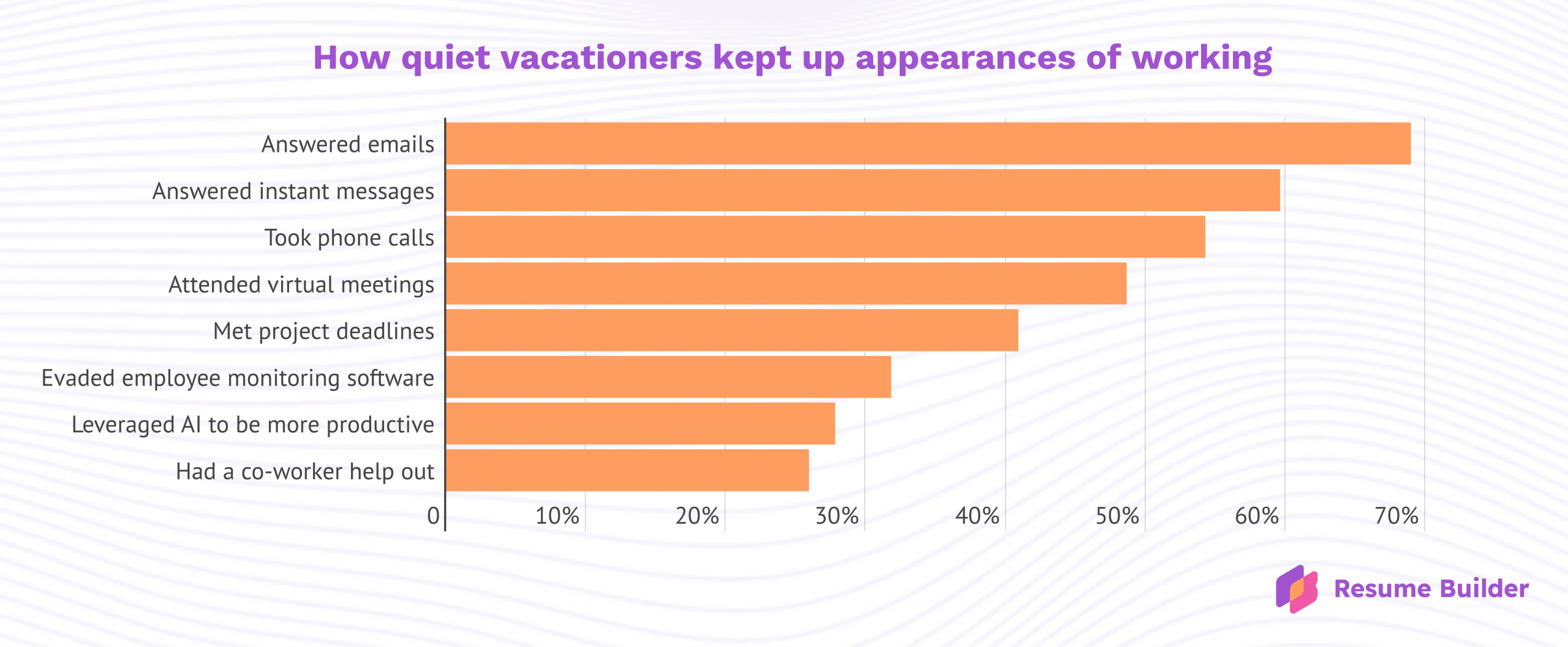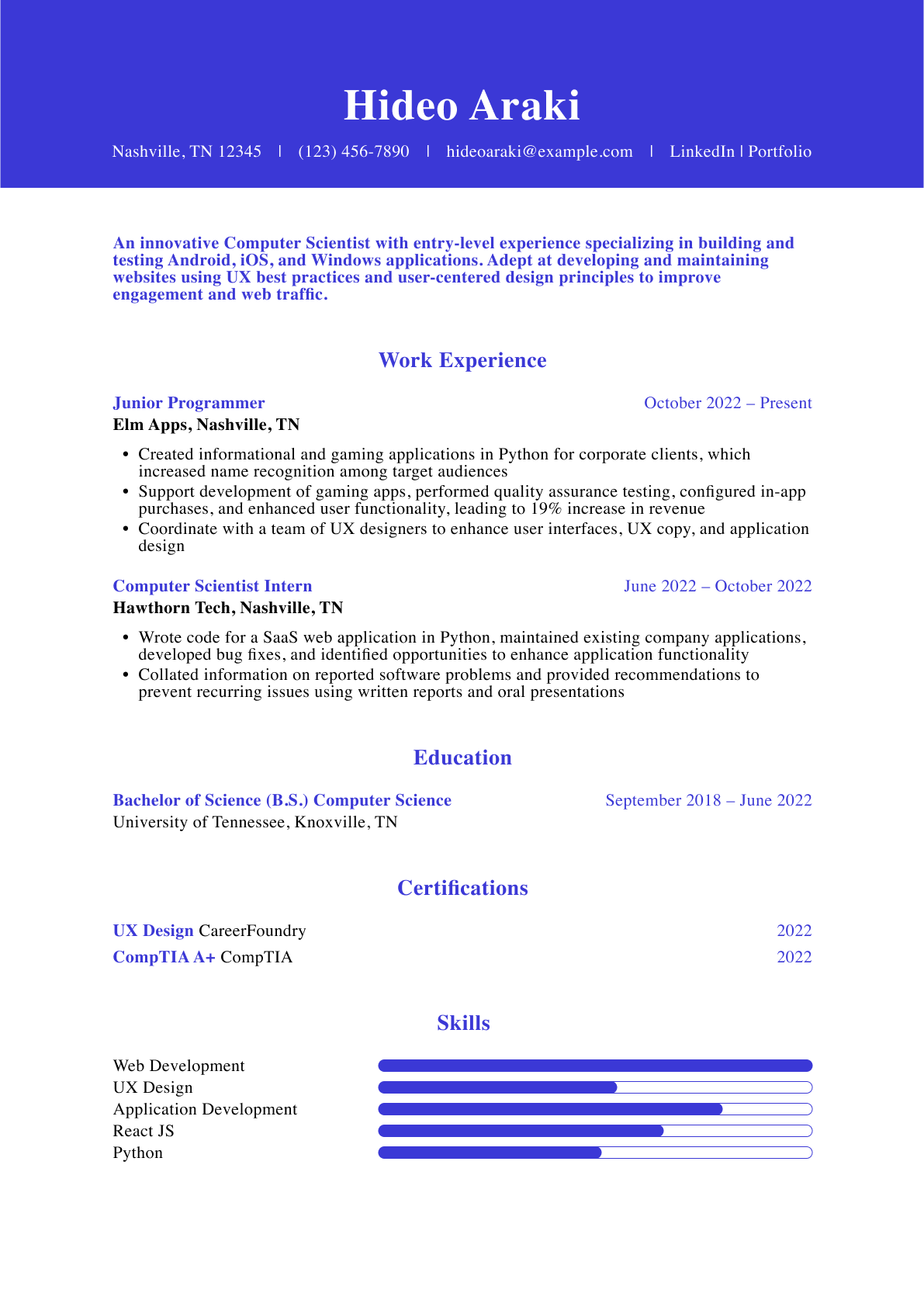Quiet vacationing happens when employees take time off without officially requesting it. Instead, they continue working, or make it look like they are, while actually being away from the office.
To find out how common this is in 2025, Resume Builder surveyed 1,200 full-time U.S. workers at the end of July. The results show the trend is still strong.
Key findings:
- 41% of workers have taken a quiet vacation this year
- This summer, 39% of employees have already or plan to quiet vacation
- Executives, Gen Zers, and in-person workers are most likely to take secret vacations
- Workers are quiet vacationing to avoid using PTO or appearing lazy
- 3 in 4 kept up appearances of working a full day
41% of Workers Have Quiet Vacationed This Year
So far this year, 41% of full-time workers say they’ve taken a quiet vacation. Among those who’ve quiet vacationed this year, 3% have taken just one quiet vacation, 48% two to three, and 28% four to five. About 11% have taken six to seven secret vacation days, and 4% have taken 10 days or more.
When asked about the longest uninterrupted stretch they took at one time, 9% say it was just one day, 58% say two to three days, 33% say four to five days, and 10% managed to take more than a week without formally requesting time off.
Looking at this summer specifically, 39% of workers say they have either already taken (19%) or plan to take (20%) vacation days without their employer’s permission.
Gen Z, Executives, and In-Person Workers Are Most Likely To Take Quiet Vacations
Gen Z workers are the most likely age group to embrace quiet vacationing. Sixty-six percent of Gen Z employees say they’ve taken time off this year without notifying their employer, and 6 in 10 have or plan to this summer. That’s compared to 46% of Millennials, 30% of Gen Xers, and just 15% of Baby Boomers.
The practice is also more common among those in senior roles. Sixty-five percent of executives and 47% of senior-level employees admit to quiet vacationing. In contrast, just 36% of entry-level and 32% of mid-level staff say they’ve done the same.
Quiet vacationing is also more prevalent among those who work fully in-person. In fact, every respondent who works entirely in-person reports having taken a quiet vacation this year. Among hybrid workers, the number is 80%. For fully remote workers, it drops to 28%.
Among those who were supposed to be in the office during their secret time off, to avoid going in, 29% said they had an appointment, 28% cited a personal issue, 24% claimed to be sick, and smaller shares blamed transportation issues (10%) or had a coworker swipe them in (9%).

“Executives often have the flexibility to step away discreetly, while Gen Z workers are more likely to find creative ways to stay connected while traveling or taking time off,” says Stacie Haller, Chief Career Advisor at Resume Builder. “Many employees feel they don’t receive enough vacation days and want to save them. In-office workers may also be quiet vacationing as a way to push back against the lack of remote or hybrid options.”
Workers Take Secret Vacations to Preserve PTO or Protect Themselves
The primary reasons why workers decided to quiet vacation include:
- 33% were saving PTO for another time
- 14% feared looking less dedicated
- 13% didn’t want to use PTO
- 12% get paid out for unused PTO
- 8% were too anxious to ask
- 8% had their request denied
- 7% feared layoffs if they took time off
“Many employees hold off on using PTO because they worry it will make them seem less committed or even expendable, which could hurt their chances of promotion or put them at risk during layoffs,” says Haller.
“Workplace culture reinforces this. When company leaders rarely take time off, employees get the message that vacation is frowned upon. Some also hang on to PTO for practical reasons. In certain organizations, unused days can be rolled over into the next year or cashed out. When you add in heavy workloads and job insecurity, it creates a cycle where employees hesitate to use the time off they’ve earned.”
3 in 4 Kept Up Appearances of Working a Full Day
To maintain the appearance of working while on a quiet vacation, most employees took steps to stay visible: 69% answered emails, 60% responded to instant messages, and 54% took phone calls. Nearly half (49%) attended virtual meetings, while 41% met project deadlines. Some relied on tools to bypass monitoring software (32%), used AI to boost productivity (28%), or had coworkers help cover for them (26%).
Nearly two-thirds of workers who joined virtual meetings during a quiet vacation (63%) used a virtual background to hide their location, and most of those (78%) used an image of their home office.
While many quiet vacationers appeared to be working, most put in only a few hours. About 6% worked less than an hour, 30% worked one to two hours, 35% worked three to four hours, and 15% worked five to six hours. Just 9% worked more than 6 hours, while 4% didn’t actually work at all.

Few Workers Faced Any Consequences For Quiet Vacationing
About four in 10 workers (37%) say their employer found out about their quiet vacation. Of those, 30% got denied a promotion, 29% lost out on a key project or opportunity, 27% were denied a raise, and 16% got fired.
More than half of quiet vacationers say they don’t feel guilty about it, with 26% feeling no guilt at all and 25% saying they don’t really feel guilty.
Methodology
This survey was commissioned by ResumeBuilder.com and conducted via the online survey platform Pollfish in July 2025. The survey included responses from 1,200 workers employed full-time in the U.S.
Learn more about Pollfish’s survey methodology or contact [email protected] for more information.
